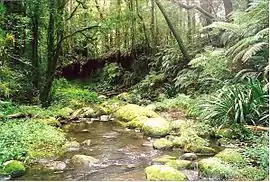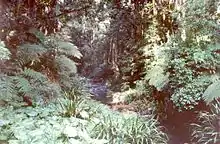Border Ranges National Park
The Border Ranges National Park is a protected national park that is located in the Northern Rivers region of New South Wales, Australia. A small portion of the national park is also located in South East Queensland. The 31,729-hectare (78,400-acre) park is situated approximately 150 kilometres (93 mi) south of Brisbane, north of Kyogle.[1]
| Border Ranges National Park New South Wales | |
|---|---|
 Brindle Creek in the Border Ranges National Park is an impressive rainforest stream. | |
 Border Ranges National Park | |
| Nearest town or city | Kyogle |
| Coordinates | 28°21′35″S 152°59′10″E |
| Established | 8 June 1979[1] |
| Area | 317.29 km2 (122.5 sq mi)[2] |
| Managing authorities | NSW National Parks & Wildlife Service |
| Website | Border Ranges National Park |
| See also | Protected areas of New South Wales |
The park is part of the Shield Volcano Group World Heritage Site Gondwana Rainforests of Australia inscribed in 1986[3] and added to the Australian National Heritage List in 2007.[4]
Geology
The Border Ranges region, which includes the McPherson Range, Tweed Range, Lamington Plateau and Levers Plateau, were formed from the erosion of the Tweed Volcano over many years. A number of volcanic plugs remain in the Border Ranges National Park.[5] Notable for extensive stands of Nothofagus moorei (Antarctic beech), the park offers a 64 kilometres (40 mi) gravel road circuit through sub tropical, cool and warm temperate rainforest types. The area was extensively logged during the 20th century, providing timber to a number of nearby sawmills.[5] The Lions Road and the Sydney–Brisbane rail corridor pass through the park at its narrow middle section.
Flora and fauna
Border Ranges and Lamington National Park are recognised as a biodiversity hotspot, containing a mixture of northern and southern flora species (the McPherson-Macleay overlap) with a number of endemic, rare and endangered species. Fauna is similarly diverse and species like the Hastings River mouse, have been rediscovered in the park in recent years.[6]

Lower areas of the park contain eucalypt forests that provide habitat for eastern grey kangaroos, red-necked wallabies and koalas.[5] Pademelons and potoroo are also found in the park as well as a diverse array of birdlife including the rare Albert's lyrebird.[5] The park is part of the Scenic Rim Important Bird Area, identified as such by BirdLife International because of its importance in the conservation of several species of threatened birds.[7]

The Border Ranges contains one of Australia's most diverse range of spider species within its montane rainforests.[8]
Facilities
Two camp grounds (car/camper and walk-in tent camping only) and a number of picnic areas, some with shelters, water and composting toilets, are available at various points in the rainforest adjacent to the road, and one picnic spot at Blackbutts Lookout, has extensive views to Mount Warning, and of the Tweed Valley, an erosion caldera which, while broken by the sea on its eastern flank, is considered larger in size than the Ngorongoro Crater in Tanzania.

References
- "Border Ranges National Park: Park management". NSW National Parks & Wildlife Service. Government of New South Wales.
- "Department of Environment Climate Change and Water Annual Report 2009-10". Annual Report. Department of Environment Climate Change and Water: 274–275. November 2010. ISSN 1838-5958.
- "Gondwana Rainforests of Australia". Department of the Environment. Australian Government. Retrieved 7 September 2014.
- "Gondwana Rainforests of Australia, Lismore, NSW, Australia". Australian Heritage Database: Department of the Environment. Australian Government. 2014. Retrieved 7 September 2014.
- Hema Maps (1997). Discover Australia's National Parks. Milsons Point, New South Wales: Random House Australia. pp. 106–107. ISBN 1-875992-47-2.
- Big Volcano Visitor Guide, reprint of article by David Charley in Over The Fence, the Newsletter of the Northern Rivers Region, NSW National Parks and Wildlife Service. Newsletter No.6, April 2000.
- BirdLife International. (2011). Important Bird Areas factsheet: Scenic Rim. Downloaded from "BirdLife International - conserving the world's birds". Archived from the original on 30 June 2007. Retrieved 29 March 2014. on 2011-10-03.
- "Spiders". Queensland Museum. The State of Queensland. Retrieved 30 October 2021.